HOP Roots
The late Mr. Tsunekazu Nishioka, known as the greatest carpenter of the period as the carpenter for temples and shrines for Horyu-ji.
Here we introduce the story of the meeting between HOP Group CEO Ishide, as the starting point of HOP, and the master carpenter Mr. Nishioka over 20 years ago.
The meeting with the master carpenter Mr. Nishioka
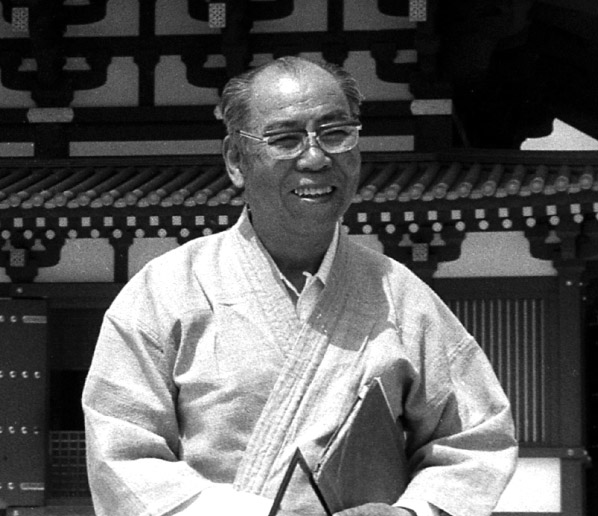
(at Yakushi-ji West Pagoda Front)
Picture: Yomiuri Shinbun
"If you do such a thing, Hinoki (Japanese cypress) would start crying…."
This is the word from a carpenter for temples and shrines/Mr. Tsunekazu Nishioka of Ikaruga. He is the carpenter for temples and shrines for Horyu-ji and undertook the rebuilding of Yakushi-ji’s West Pagoda in Nara and Horyu-ji’s Three-Storied Pagoda.
For the perfect construction diagram and construction plan designed by architectural scholars with modern structural engineering, he was against the construction method due to his carpenter’s experience, intuition, and mentality, and then he eventually completed to rebuild many Pagodas by persisting his inflexible masterfulness minds
The oldest wooden architecture in Japan - Horyu-ji. It is precisely the most beautiful and oldest existing architectural building in the world.
Mr. Nishioka always consider "how we can endure the Pagoda’s framework for 1000 years", "Understand the mind of tree and brings it to the best use", and "Carrying on the tradition to the present time and succeeding it to the next generation".
To pursue these thoughts, Mr. Nishioka considered tree’s life as his own life and continued refusing to drill a hole in wooden material (as drilling a hole in his hand) for steel frame to reinforce the wooden parts.
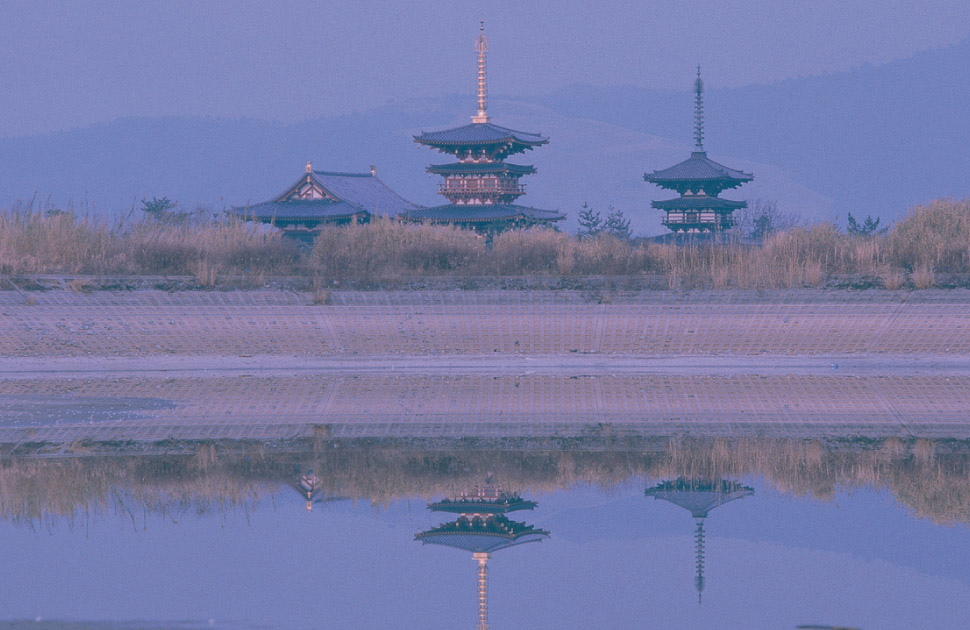
Because iron rust could ruin and kill the wooden materials. I believe that the enthusiasm is a Japanese mind rather than the mind of one carpenter for temples and shrines, and comes from the strong sense of responsibility for the tree culture. In his book of "Ki no kokoro (Tree Minds)", Mr. Nishioka mentioned, "Hinoki (Japanese cypress) has its own Hinoki’s life. The life is longer than iron’s and concrete’s."
I was deeply impressed by the book approximately 20 years ago and wanted to see him by any means. Because I went to Kyoto and Nara often to take pictures, I knew the rebuilding of Yakushi-ji’s West Pagoda very well.
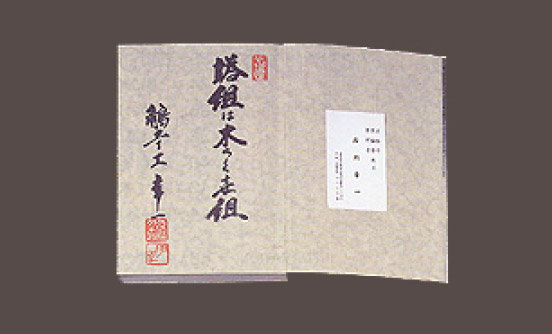
The word of Mr. Nishioka - presented to the author
When I visited Kyoto in November, autumn was well advanced and the day was very cold. The time when I arrived at the precincts of Yakushi-ji was just passed the noon.
I went around the precincts and left for construction site. There was nobody there due to lunchtime but I found a prefabricated field office on the other side. I thought it is not a bad idea to get just Mr. Nishioka’s address from the office and then go to the village of Ikaruga where he lives.
"Excuse me but where is Master Tsunekazu Nishioka ….."
A person who raised his head and turned around was Mr. Nishioka.
He was alone and drawing some kind of macrograph with Chinese ink.
He was very gentle with smiling but his face was looked like strong-willed.
At that time, I believe Mr. Nishioka was around 70 years old but he seemed to be lively and looked around 60 years old at most from every standpoint.
This meeting changed my stance and the way of thinking for architecture hereafter.
I apologized my rudeness of sudden visit and told him "Since Hokkaido does not have a long history of culture, I came here to study about it. I also came here because I was impressed by your book and really wanted to meet with you. I never thought I could see you at all." I continued to explain desperately. Mr. Nishioka took rest from his busy work and dealt with me.
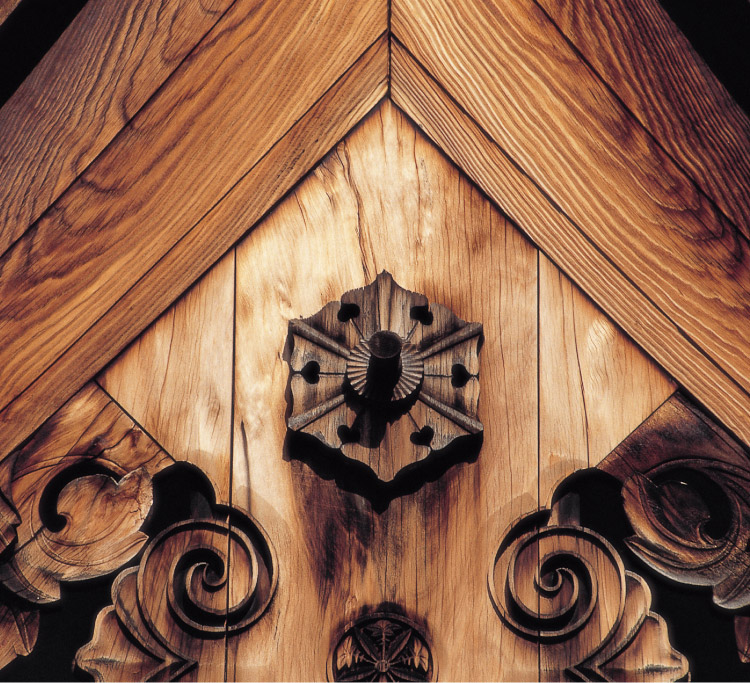
"What you are building now becomes a culture of the town after 50 years. That is the building we have to construct. If we make the best use of real materials rather than spending more money, we can create beautiful things. And the beautiful things must be remained. I disagree that it is beautiful because it is old, but I agree that it is beautiful because it surely is a real thing, even getting old. Although I understand you are engaged in designing, not only you draw a drawing but also you should breathe a life into the building with craftsmen together. So you must have that kind of sense of responsibility to deal with architecture."
Gentle and strict words from Mr. Nishioka.
The words from a person who has been working with the history of 1000 years.
I found a deep spirit and a deep belief in his words.
I believe it's just like the proverb "It opened my eyes". I studied a little about architecture at school; however, when I start designing, I act as an skillful architect to be upset with craftsmen and act as only the person who can build a special things, but blame others for my own mistakes. I resented a client for not understanding me at all and was demolishing a town by attempting to create a building for getting much attention... Mr. Nishioka took time to show me around the site.
When we look at building around ourselves, the functionally prioritized industrial products as being called "Rationalization" flow into the society, and by using the products, ready-built housings and residential estates are continuously built as a stateless culture. Certainly even if it looks like a beautiful new house, is it only me sensing cold wind getting though my mind when I look at the house with fake materials?
As the responsibility of an architect, I swear to the master carpenter Tsunekazu Nishioka in my mind that I will aim at designing something to be a part of Japanese culture and creating a new architecture culture with strong confidence and belief as "A typical Japanese thing is a typical international thing."
Mr. Nishioka received " Architectural Institute of Japan Award", the highest honor for architects, and he also received "Eiji Yoshikawa Culture Award". Without any doubts, he is a right person to be a representative cultural figure of Japan beyond his occupational position as the master carpenter for temples and shrines.
After that, with my favor, he accepted carpenters from our company as his pupils.
The wonderful spirits they learned from him are passing on to us even now.
Writing/ Kazuhiro Ishide Photo/Photograph Essay Collection from "KOKOROKIKO"
In remembrance of the master carpenter Nishioka, now we introduce the conversation with Mr. Kenji Omori, a carpenter for temples and shrines and for Yakushi-ji rebuilding.
When HOP established Kyoto branch, it launched a small class called "HOP Mori no kyoushitsu (Class for Forest) in Honen-in temple" for people to understand about the goodness of domestic timbers as much as possible. At that time, Urasenke school of tea ceremony / the 16th head of school Mr. Soushitsu Sen and two writers / Mr. C.W. Nicol & Mr. Wahei Tatematsu willingly accepted the lecture because they all sympathized our idea that house building by using artificial forest eventually leads to protect a forest.
At this time, we moved the class to Sapporo and carried out a lecture with Mr. Kenji Omori, a carpenter for temples and shrines.
Mr. Omori whom Kazuhiro Ishide adores as "Spiritual Mentor" was instructed by the late Mr. Tsunekazu Nishioka, Horyu-ji’s master carpenter for temples and shrines, and was engaged in measurement survey and rebuilding for a national treasure of Three-Storied Pagoda. As commemorating Sapporo lecture of "Mori no kyoushitsu (Class for forest)", we introduce the conversation between Mr. Kenji Omori and HOP Group CEO Ishide.

Mr. Omori, you are a pupil of a doctor of engineering Mr. Kiyoshi Asano who undertook a task of disassembling many old temples, right? Because of the relationship, I heard you are recommended for the measurement survey of Yakushi-ji East Pagota.
While Dr. Asano teaches the Japanese architecture (traditional architecture) at the university, he plays a role of a Commissioner for Protection of Cultural Assets and is a great authority figure even Cultural Affairs Agency asked him to do a job. It took me for years to be his pupil and then when I was studying architecture from scratch again, the topic of rebuilding Yakushi-ji West Tower was just appeared.
Because Yakushi-ji has East Pagoda, which was build 1300 years ago and survived from being burned down, the rebuilding for West Pagoda desperately needed the measurement survey for East Pagota. To my delight, Dr. Asano recommended me as his exclusive assistant for the survey. At that time, the master carpenter was Mr. Tsunekazu Nishioka, known as "the last carpenter for temples and shrines". So Mr. Nishioka was my direct superior.
The master carpenter Nishioka is a great carpenter who accomplished restoring the oldest wooden architecture Horyu-ji, and Yakushi-ji Kondo/West Pagoda, and Hourin-ji Three-Storied Pagoda. As a matter of fact, I am here as an architect because I met Mr. Nishioka as "Spiritual Mentor". Then I, even just one chance, wanted to talk with Mr. Omori because I have a great deal of talk about.
I see. Because Mr. Nishioka also participated in "the Showa great repair of Horyu-ji", he was a crucial person to restore Yakushi-ji. The master carpenter was a old-style person saying "Steal the techniques by watching them and learn them by stealing". Needless to say about his viewpoint and research method for architectural restoring traces, I have learned his way of writing to persuade people, his attitude to others, and even his way of talking. I could do it because I was there with the great person. So I am very thankful to have existed in such a good place.
Yakushi-ji is utterly unmoved by even having 600 tons of load as incredibly heavy weight and has been standing up to winds, snow, and big earthquake for 1300 years. It was very valuable experience that I directory touched the ancient foundation method (groundwork) and learned even about how to build the temple.
I remember as if it were yesterday, under the tutelage of the master carpenter Tsunekazu Nishioka

I wanted to learn the traditional Japanese architecture so I jumped into the architectural world. Therefore, I was frequently looking around tea arbors and tea-ceremony rooms in Kyoto and Nara whenever I had free time. One day, I encountered the book that master carpenter Nishioka wrote. When I read the book, I never forget that I was impressed like my soul being shaken. Since then, my thought to see the master carpenter was getting stronger day by day, and I was intolerant of waiting, then I came to Yakushi-ji under the rebuilding many times.
Was it the time of West Pagoda construction or the central gate construction?
Because it was the time of the cloister, it was more than 20 years ago.
Despite I made a sudden visit to the master carpenter Nishioka, he willingly accepted me and told me like fatherly advice. "What you are building now becomes a culture of the town after 50 years. That is the building we have to construct. If we make the best use of real materials rather than spending more money, we can create beautiful things. And the beautiful things must be remained."
The stance for not leaving anything but the exception of genuine articles is valuable.
I still remember that the words from the master carpenter who challenged the battle with the history of 1000 years struck my heart deeply. Because of this fate, our company’s carpenters became the pupils of the master carpenter.
Much time has passed since then but the words, still remained in my mind deeply, are the starting point of my architecture. And they became the foundation of house building in my own method. It inspired me so I laid a seed for realizing my ideal thoughts and ideas, and the consequent result after laying the seed bore a fruit by my hard work. The fruit is a new housing supply system called HOP (Housing Operation Project) by using mainly Hokkaido timbers.
I see. Domestic timers are certainly good timbers. Especially the master carpenter Nishioka also told me that local timbers should be consumed locally as the best practice. He also taught me "Treating a tree as an animate thing and making the best use of the animate thing for building is a task for carpenter." "If Hinoki (Japanese cypress) is 1000 years old, a building built by the Hinoki would stand there for more than 1000 years."
I visited to engage in building investigation for the national treasures and the important cultural properties every year. Although I have been involved in architecture for a long time, I was impressed even now that the building was built by the comprehensive high technology. The master carpenter often mentioned "The techniques of craftsmen in the Asuka period which built Horyu-ji 1300 years ago never be caught up by the modern techniques." If temples and shrines that we build are remained for a long time, we would like to build the buildings making us proud even a little when the future generations see them.
A demon for work was also a compassionate god after leaving the site.

I really have to raise my hat to the forward manufacturing for the next 1000 years. The master carpenter had his own theory that the rebuilding of wooden architecture by traditional construction method is "Experience and intuition of a carpenter for temples and shrines are everything". Therefore, I heard that he rebuked government officials and scholars many times because they wielded the regulations such as the Building Standards Act.
The master carpenter never be compromised with his work at all and he was a strict person as his being craftsmanship. But once he leaves his work, he is a person with deep humanity and loyalty. By the way, because I lost my wife early, one day, a letter came to my daughter from the master carpenter. In the letter, it described a lot of fine things that my wife did before her death. I was very glad to have his warm thoughtfulness to heal my daughter’s sadness. My daughter still keeps the letter as her treasure.
I understand your daughter must have been very glad to have the letter.
I think that the master carpenter’s strict stance toward the works probably comes from the responsibility for being a carpenter for temples and shrines of the national treasure architecture. When the master carpenter showed me around the construction site of Yakushi-ji, he told me "Design is not created only by a drawing but you have to breathe a life into the architecture with craftsmen together. So you must have that kind of sense of responsibility to deal with the architecture." By the way, how do you think the wooden architecture should be in the future?
What the wooden architecture need is effective use of domestic timbers at present.
In recent years, a number of prefabricated and concrete buildings have been increasing and a number of successors who succeed to carpenter’s techniques of wooden architecture have been declining. This is a matter of regret. Therefore, I opened a training school of carpenter for wooden tradition in September 2003 for the purpose of young carpenter’s technological improvement and rearing. We instruct the carpenters to be able to read and draw of construction diagram, and to draw a set of design and a working drawing.
In addition, for training highly skilled technicians, the training school for successors of wooden tradition technique was opened in September 2000. To the best of my poor ability, I hope the high techniques will be passed on to the next generations by my instructions. In addition, I am focusing my energy on how domestic timbers can be used for general consumers.
I think Mr. Omori’s stance to pass our present techniques on to the next generations is wonderful. I started using artificial forest’s Sachalin fir and Japanese larch in Hokkaido for architecture because they were not utilized effectively so far. I use timbers with approximately 40 years. Even if those trees are slender, they can be reborn to be strong timbers as glued lamination board by processing.
In a sense of taking good care of forest, I try to plant trees, which would be matched with the volume of timbers to be used for building a house. Because they will be used as timbers again after a few decades, it contributes the utilization and rearing of forest resources. Since my company also developed new architectural metals with Forest Products Research Institute, we can build a house with the strength of three times larger than ordinary house. Since it does not use nails, it is easy to be disassembled and approximately 80% of the disassembled structural materials can be reused when it is reconstructed after a few decades. I learned from Horyu-ji and Yakushi-ji about the way of reuse with making the best use of timber.
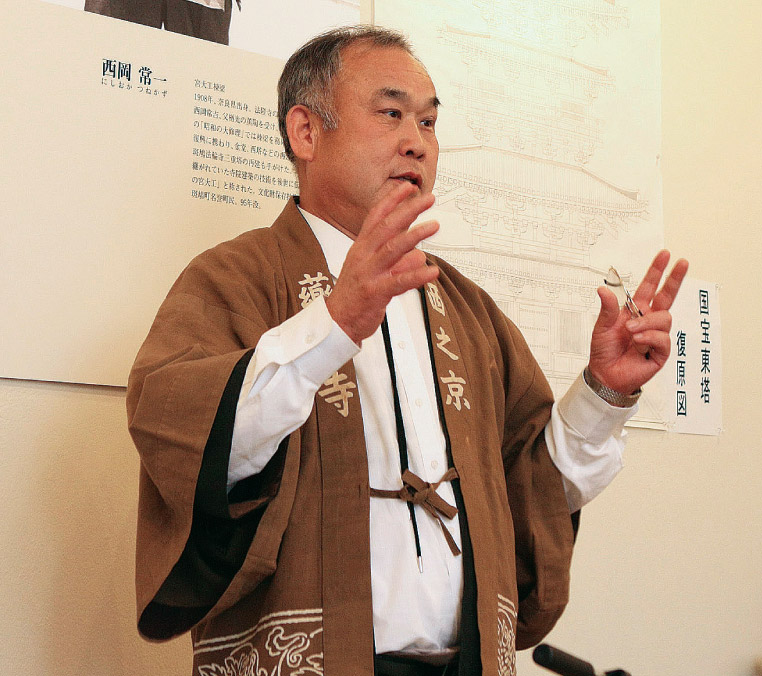
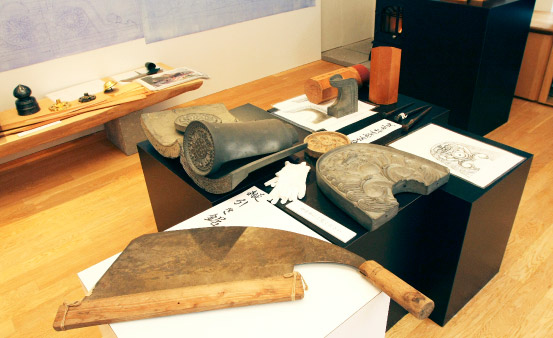
For example, in Kyoto, there is a slender tree called Kitayama Sugi (Japanese cedar), which is essential for the building style of tea arbor and the building style of tea-ceremony room, and using this tree develops the high architectural techniques.
I think the enthusiasm to use timbers importantly exists there.
Although I had a lot of experiences by trial and error and repeatedly made many mistakes, finally I can build most houses only by domestic timbers, particularly Hokkaido timbers. Local productions are consumed at local places. In a sense, it is "Local timbers for local consumption". Now I believe we should consider about how we can use the trees that our predecessors planted, and it is time to act for everyone to gather ideas to face the issue.
I completely agree with the idea. I always felt that consumers and technicians of building company/construction company do not understand about the merits of Japanese cedar and Japanese cypress. Japanese cypress contains oil to prevent deformation so it can be used for a building, which remains for a long time.
In addition, when Japanese cedar is used for floor material, people would sense warm feeling; therefore, I suggest to use Japanese cedar for floor material of a reinforced concrete school. Despite Japanese cedar and Japanese cypress have superior durability; people tend to use inexpensive foreign timbers. Certainly people tend to believe that wooden building is more expensive in consideration with its costs; however, it will last longer, and as the result, it will be relatively cheaper than a concrete building.
Real good things will not be getting older. Creating things with durability is the best for environment protection.
I agree. I often use the expression "Wooden architecture will not be getting older but will be getting deeper as time passes". A new wood would gradually be blended with surroundings as a few decades passed and it adapts itself as if it existed there from the beginning. I believe that wooden architecture has tasteful deepness due to using real materials and calmness is revealed from it.
The person as being engaged in architecture must consider about at least 50 years later, 60 years later, or maybe a longer span than those number of years. In my responsibility as an architect, night and day, I have been challenging to succeed the housing culture as heritage for future through wooden architecture with using domestic timbers. "Building a house" means "Building a customer’s assets". Therefore, it is needless to say about durability, a house would express about a resident’s life conception and I would like to continue building a house in where our customers can feel their happiness from now on.
Although the country mentioned about a 200 years house, I have a doubt whether the techniques for building the 200 years house by woods would be left then. Nothing would be advanced only by the commands. Because our country prioritizes economical costs, it does not take much time to work for the house. That is why I think we should turn our eyes more on the idea of durability now, which our predecessors fostered.
I agree totally. Building a house with durability would be the most important and valuable thing to consider for global environmental problem that everybody's talking about nowadays. Mr. Omori, thank you very much.
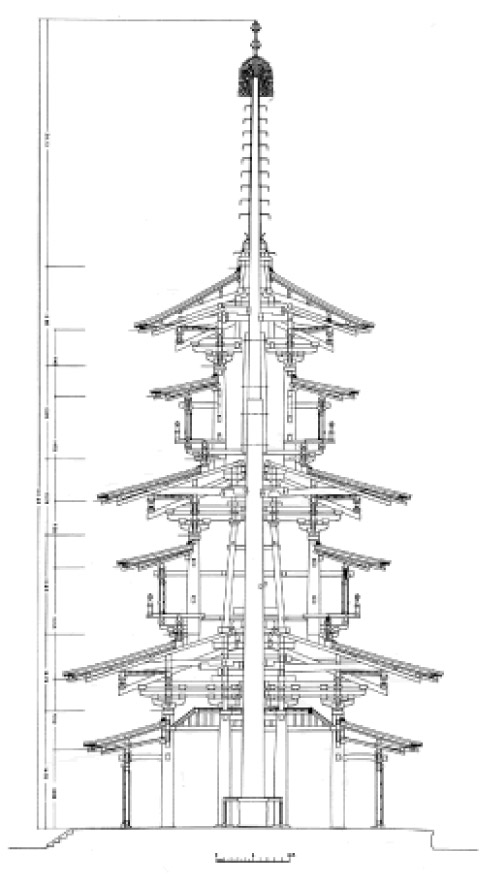

 HOP WORKS
HOP WORKS WORKS OTHER THAN HOUSES
WORKS OTHER THAN HOUSES


